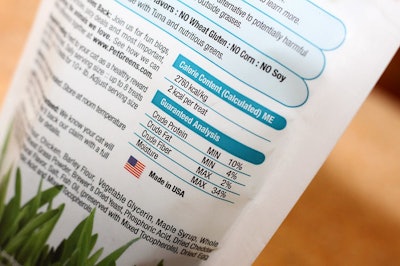
When it comes to pet food packaging, plastic bags have become nearly the standard for product categories like dry food and treats. With superior graphics, barrier properties and durability, plus often the convenience of a resealable opening, plastic bags offer many positives.
Their main downside is that they’re not sustainable. The multiple layers of material that comprise plastic bags, contributing to their benefits, make them nearly impossible to recycle. Or, as my colleague Tim Wall put it: “Those brightly printed, sturdy materials may ensure freshness on par with human foods, but they can be a bear to recycle,” he wrote, sharing information from Scott Whiteside, Ph.D., food science professor at Clemson University, who presented on packaging as part of the Petfood Essentials CONNECT•ED short course in late 2020.
“Especially in the plastics market, very seldom will you find one plastic material that will handle and give you all the properties you need,” Whiteside said. “Usually they're going to be multi-layer, either co-extrusions or adhesive laminations. When you start making those types of multi-layer materials, even though it looks like one single material, to recycle or send it through a process to extract those out becomes very costly and very difficult. So usually, there's not a large recycling stream there.”
In fact, the Pet Sustainability Coalition (PSC) says the cost of recycling is more than the value of the plastic materials in the package. “As a result, PSC estimates that over 99% of all pet food bags in the U.S. are disposed of in a landfill rather than recycled,” according to a press release.
The same issue can apply to paper pet food bags with non-paper components, such as clear plastic windows that allow consumers to see the product inside.
First stage of pet food packaging recycling program shows success
The ability to recycle packaging is increasingly important to consumers, along with sustainability in general. In an early 2020 global survey of pet owners, Euromonitor found that 60% chose “recyclable” as a trustworthy product label claim, over related claims such as eco-friendly and locally sourced, both close to 55%, and sustainably produced at nearly 50%. (Interestingly, other choices for label claims were not as obviously related, including natural and organic, and these pet owners considered recyclable and eco-friendly as more trustworthy.)
The Euromonitor data appeared in a webinar by Kemin on sustainability in pet food. Regarding sustainable packaging, the presenter said that alternatives to plastic bags can include packaging made from recycled materials, 100% recyclable or compostable packaging, plus biodegradable bioplastics and reusable containers.
All those are indeed alternatives and are being tested by pet food companies and packaging suppliers, but I think it’s fair to say such experimentation is in the early stages. One recent example—a success so far—comes from PSC’s Flex Forward, a “return-to-retail packaging pilot program” launched in August 2020 in partnership with Earth Animal, a manufacturer of pet food, treats and other pet products, and Pet Food Experts, a pet food distributor.
The program exceeded its phase one goal of collecting 5,000 pounds of used, flexible plastic pet food and treat packaging, PSC said. In this phase, more than 120 independent pet retailers in Oregon and Washington state received containers to collect all types of flexible plastic pet food and treat bags from pet owners. (I believe this applied to products sold in those stores.) Participating retailers also received store associate training, digital content and incentives to encourage pet owners to bring back their packaging, at no cost to the retailers.
Phase two of Flex Forward will involve testing the recyclability of the collected materials, with a goal of creating recycled plastic material that could be used to manufacture other pet care goods, such as beds or toys, to market or donate to pet rescues across the country. (You can find out more during PSC’s Unpacked21 virtual event on sustainable packaging in the pet industry, taking place February 23-24, 2021.)
New initiatives worth getting excited about
The Flex Forward program brings to mind existing initiatives such as TerraCycle, which a handful of pet food companies have used for several years to encourage return of their products’ plastic bags for potential recycling. But that has been pretty limited, as has TerraCycle Loop’s program, in which consumers can refill reusable containers of certain goods. And the same with biodegradable or compostable bioplastic pet food packaging, being provided by a few suppliers and tested by a handful of pet food or treat companies.
Still, I find it inspiring that such initiatives and tests are happening, and I’m hopeful that one or more will succeed and eventually be funded and scaled up to have a true impact. Other intriguing ideas have been floated; Wall proposed developing a pet food pod, with the pet food encased in a dissolving wrapper, only one that’s edible (unlike with the Tide pod challenge!). A gelatinous material such as fish gelatin or a cellulose-based material might fit the bill, Whiteside suggested. And the pods could be sold in a refillable container, possibly via home delivery, Wall added.
Considering the rising popularity of direct-to-consumer pet foods and home delivery services, the concept seems viable. The point is, sustainability issues like plastic packaging can be resolved, given enough thought, collaboration, scientific experimentation and funding. That’s something to get excited about.



















